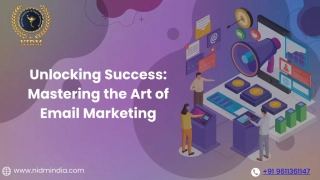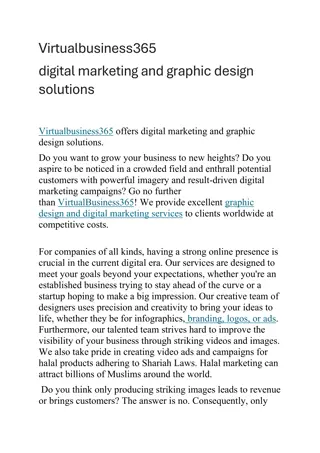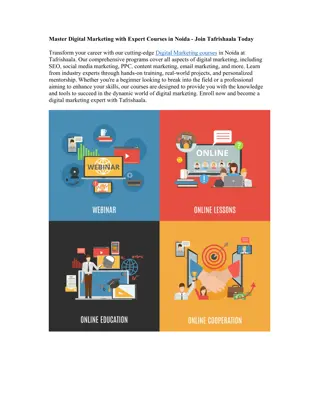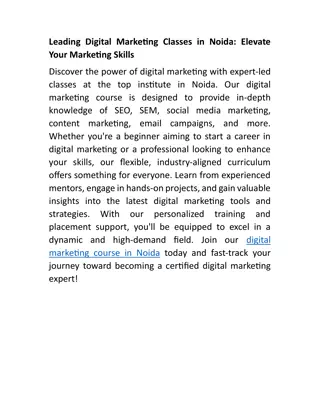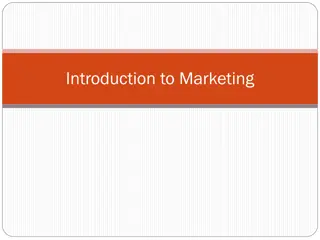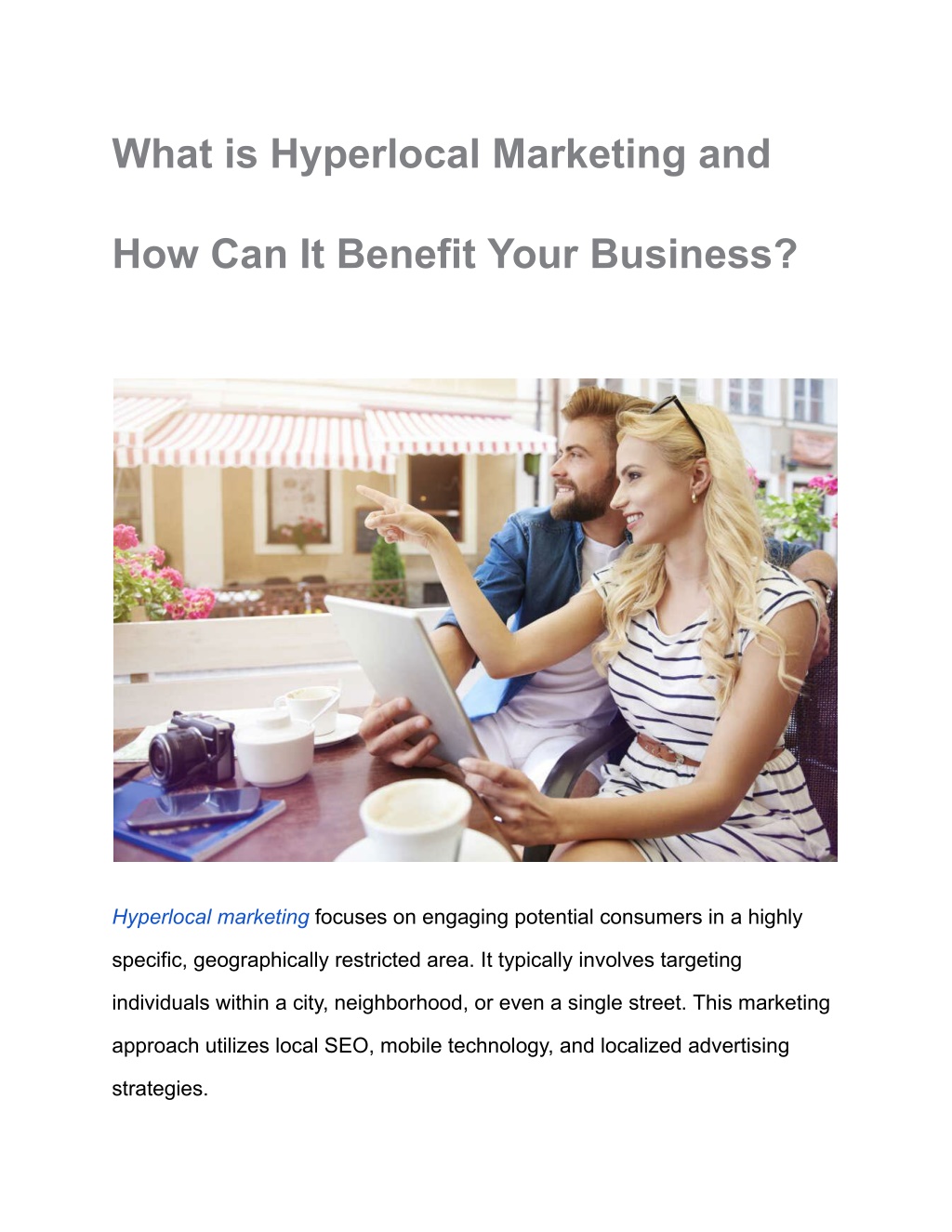
What is Hyperlocal Marketing and How Can It Benefit Your Business_
What is Hyperlocal Marketing and How Can It Benefit Your Business? explores an increasingly popular and highly effective marketing strategy that allows businesses to focus their efforts on a specific geographic area.
Download Presentation

Please find below an Image/Link to download the presentation.
The content on the website is provided AS IS for your information and personal use only. It may not be sold, licensed, or shared on other websites without obtaining consent from the author. Download presentation by click this link. If you encounter any issues during the download, it is possible that the publisher has removed the file from their server.
E N D
Presentation Transcript
What is Hyperlocal Marketing and How Can It Benefit Your Business? Hyperlocal marketing focuses on engaging potential consumers in a highly specific, geographically restricted area. It typically involves targeting individuals within a city, neighborhood, or even a single street. This marketing approach utilizes local SEO, mobile technology, and localized advertising strategies.
Mobile Optimization: Ensures visibility when users search for services on smartphones or tablets in a specific area. Local SEO: Uses region-focused keywords and content to improve search engine rankings within a geographical zone. Geotargeting: Personalized ads based on consumers precise locations. Social Media Advertising: Platforms like Facebook and Instagram allow targeting based on location tags and check-ins. Implementing hyperlocal marketing can enhance a business s ability to connect with local customers, thus driving more foot traffic and boosting sales. Concept of Hyperlocal Marketing Hyperlocal marketing targets customers within a very specific geographic area, often a few blocks or streets. It focuses on engaging potential customers who are in proximity to a business s physical location. This marketing strategy utilizes digital tools like GPS technology, online directories, and social media to reach local audiences. Key Elements Precision Targeting: Focuses on extremely localized regions. Immediate Reach: Targets customers who are ideally situated to make spontaneous purchases. Community Engagement: Enhances the relationship between local businesses and their communities. Real-Time Offers: Promotes time-sensitive deals to increase foot traffic. The Core Elements of Hyperlocal Marketing
Effective hyperlocal marketing requires a focus on: 1. Geotargeting Technologies: Utilizes GPS, Wi-Fi, and IP address data to identify target customers precise locations. 2. Localized Ad Campaigns: Tailors advertisements to specific geographic areas, catering to local interests and needs. 3. SEO and Keywords: Incorporates local keywords and search engine optimization to increase discoverability. 4. Customer Reviews and Testimonials: Encourages and leverages positive local customer feedback. 5. Social Media Engagement: Uses local social media channels and groups for community interaction and promotion. 6. Local Partnerships: Collaborates with nearby businesses and influencers to expand reach. These elements ensure hyperlocal marketing effectively targets and engages the community. How Hyperlocal Marketing Differs from Traditional Marketing Strategies The goal of hyperlocal marketing is to engage customers by focusing on a particular geographic region and using location-based data. Traditional marketing often aims for a broader audience, employing general demographics and psychographics.
Geographical Scope: Hyperlocal: Targets specific local neighborhoods or small areas. Traditional: Targets broader regions, often national or international. Personalization: Hyperlocal: Utilizes local SEO, geotargeting, and community-based promotions. Traditional: Uses mass media like TV, radio, print ads, and large-scale digital campaigns. Customer Engagement: Hyperlocal: Enhances customer experience through localized offers and events. Traditional: Relies on generic messaging suitable for a wide audience. Data Utilization: Hyperlocal: Leverages real-time location data and local trends. Traditional: Employs historical data and broad market research. The Role of Technology in Hyperlocal Marketing Technology is the driving force behind hyperlocal marketing, enabling businesses to target audiences with precision. Geolocation services allow firms to pinpoint customers exact locations, delivering personalized offers through mobile devices. Social media platforms amplify reach by allowing targeted ads based on geographic data. Geofencing: Establishes virtual boundaries to send notifications when customers enter or exit a defined area.
Beacon Technology: Uses Bluetooth to communicate with nearby devices, enhancing in-store engagement. Data Analytics: Analyzes local customer behavior, preferences, and trends to tailor offerings. Technology thus ensures relevancy and immediacy in hyperlocal campaigns. Why Hyperlocal Marketing is Crucial for Small Businesses Strong links to the local community are frequently essential to small enterprises. Hyperlocal marketing helps them target potential customers within a specific geographic area. This strategy offers numerous advantages: Higher Engagement: The target audience is more receptive to localized material. Cost-Effective: Focused marketing limits expenses. Increased Foot Traffic: Targeted ads attract local customers to physical stores. Customer Loyalty: Personalized approaches nurture strong customer relationships. Competitive Edge: Distinguishes smaller companies from bigger ones. By utilizing hyperlocal tactics, small businesses can optimize their marketing efforts and drive meaningful community connections. Exploring the Benefits of Hyperlocal Marketing Hyperlocal marketing offers several advantages. Among them are:
Personalized Engagement: Reaching out to customers with more tailored content based on their precise location. Higher Conversion Rates: Local targeting typically leads to higher engagement and conversion due to the relevance of the messaging. Improved Customer Loyalty: Building stronger connections with customers helps in fostering loyalty and repeat business. Cost Efficiency: Reducing wasteful ad spending by focusing resources on a more targeted area. Immediate Impact: Real-time marketing responses to local events, trends, and behaviors. These benefits underscore why businesses increasingly adopt hyperlocal strategies. Targeting the Right Audience with Hyperlocal Strategies Hyperlocal marketing enables businesses to cater to highly specific and localized audiences. By using tools such as geofencing, businesses can create marketing messages relevant to consumers in precise locations. Key elements include: Local SEO: Optimizing content for local search terms to increase visibility. Geotargeted Ads: Displaying ads to consumers based on their current location. Community Engagement: Participating in local events and social media groups. Localized Content: producing material based on the customs, traditions, and interests of the community. Mobile Optimization: Ensuring websites and offers are mobile-friendly for on-the-go consumers.
These strategies create a personalized experience, fostering customer loyalty and improving conversion rates. Effective Techniques for Hyperlocal Marketing 1. Leverage Local SEO Optimize the business s website with localized keywords, Google My Business listings, and customer reviews. Concentrate on localized long-tail keywords. 2. Geo-Targeted Advertisements Utilize platforms like Google Ads and Facebook Ads to create geo-targeted campaigns. Focus on a defined radius around the business location to reach potential nearby customers. 3. Localized Content Create blog posts, videos, and social media updates relevant to the local community. Highlight local events, collaborations with other local businesses, and community projects. 4. Partnerships with Local Influencers Work together with influential locals who enjoy a large following in the community. Utilizing Social Media for Hyperlocal Campaigns Businesses can effectively harness social media for hyperlocal campaigns. Social platforms offer tools for precise geographic targeting to engage local customers. Key strategies include: Geo-targeted ads: Platforms like Facebook and Instagram allow ads to be shown based on specific locations. Localized content: Creating content that resonates with the local community fosters engagement.
Local influencers: Partnering with local influencers enhances visibility and credibility. Community groups: Engaging with local community groups boosts brand presence. Event promotions: Promoting local events through social media attracts nearby participants. These tactics ensure a concentrated and impactful hyperlocal marketing approach. The Power of Local SEO in Hyperlocal Marketing Local SEO serves as a crucial element in hyperlocal marketing strategies. Local search optimization allows companies to: Increase Visibility: Appear prominently in local search results, driving more foot traffic. Target Specific Audiences: Reach specific geographical areas to attract a highly targeted customer base. Build Trust: Establish credibility through local reviews and listings on platforms like Google My Business. Enhance User Experience: Provide relevant and localized content that meets users immediate needs. Improve Conversion Rates: Convert local searchers into customers more effectively due to the relevance of the services offered. Hyperlocal marketing leverages these advantages, making businesses more competitive. Success Stories: Businesses Thriving with Hyperlocal Marketing
Several businesses have harnessed the power of hyperlocal marketing to achieve remarkable success: 1. Joe s Coffee: Increased daily foot traffic by 25%. Utilized location-based promotions tailored to the immediate neighborhood. 2. Fresh Farm Groceries: Grew local customer base by 35%. highlighted things made locally by utilizing social media. 3. Smith s Auto Repair: Boosted appointment bookings by 40% through geo-targeted ads. Sent personalized offers to nearby vehicle owners. These examples illustrate the potential of hyperlocal strategies to drive substantial growth for diverse businesses. Measuring the Success of Your Hyperlocal Marketing Campaigns The following crucial metrics are used to monitor the effectiveness of hyperlocal marketing campaigns: Foot Traffic: Increase in physical store visits. Sales Data: Changes in sales post-campaign. Customer Engagement: Social media interactions and local reviews. Coupon Redemption: Usage rates of localized promotions. Website Analytics: Changes in local website traffic and conversions. Customer Feedback: Responses through surveys or direct feedback. Market Penetration: Increase in local market share.
These metrics provide a comprehensive view to assess the effectiveness of targeted efforts in specific locales. Common Challenges and How to Overcome Them Hyperlocal marketing presents several challenges: 1. Data Accuracy: Issue: Inaccurate local data can misinform strategies. Solution: Invest in reliable data sources and regularly update databases. 2. Resource Allocation: Issue: High resource demand for personalized content. Solution: Use automation tools for efficiency. 3. Understanding Local Preferences: Issue: Misjudging community preferences. Solution: Consult with local authorities and carry out market research locally. 4. Technology Integration: Issue: Incompatibility of new technology with current infrastructure. Solution: Collaborate with IT for seamless integration. By addressing these challenges, businesses can optimize their hyperlocal marketing efforts effectively. Future Trends in Hyperlocal Marketing Hyperlocal marketing is constantly evolving, driven by technological and consumer behavior changes.
AI and Machine Learning: These technologies enable businesses to offer personalized recommendations based on individual preferences and local trends. Voice Search: Increasing the use of voice-activated devices will amplify the need for businesses to optimize for local voice search queries. Wearable Tech: Wearables can provide real-time location data, enhancing the precision of targeted marketing efforts. Enhanced Data Analytics: Better analytics tools will offer deeper insights into hyperlocal market trends and consumer behaviors. Sustainable Practices: Growing consumer demand for sustainability will push businesses toward hyperlocal solutions that emphasize local sourcing and community engagement. Maximizing Business Growth through Hyperlocal Marketing Hyperlocal marketing offers businesses precise targeting of potential customers in specific geographic areas. By focusing on localized audiences, companies can: Increase Relevance: Create tailored messages that resonate with local consumers. Boost Engagement: Promote local events, discounts, and offers to foster community connection. Optimize Ad Spend: Allocate the budget more efficiently by targeting highly relevant demographics. Methods include: 1. Local SEO: Optimize website content for local search queries. 2. Social Media: Talk to local authorities and community organizations. 3. Direct Mail: Send promotional materials to nearby residents.
This strategy enables businesses to establish a dominant local presence, driving sales and loyalty. What is Hyperlocal Marketing and How Can It Benefit Your Business? Share : Hyperlocal marketing focuses on engaging potential consumers in a highly specific, geographically restricted area. It typically involves targeting individuals within a city, neighborhood, or even a single street. This marketing approach utilizes local SEO, mobile technology, and localized advertising strategies. Mobile Optimization: Ensures visibility when users search for services on smartphones or tablets in a specific area. Local SEO: Uses region-focused keywords and content to improve search engine rankings within a geographical zone. Geotargeting: Personalized ads based on consumers precise locations. Social Media Advertising: Platforms like Facebook and Instagram allow targeting based on location tags and check-ins. Implementing hyperlocal marketing can enhance a business s ability to connect with local customers, thus driving more foot traffic and boosting sales.
Concept of Hyperlocal Marketing Hyperlocal marketing targets customers within a very specific geographic area, often a few blocks or streets. It focuses on engaging potential customers who are in proximity to a business s physical location. This marketing strategy utilizes digital tools like GPS technology, online directories, and social media to reach local audiences. Key Elements Precision Targeting: Focuses on extremely localized regions. Immediate Reach: Targets customers who are ideally situated to make spontaneous purchases. Community Engagement: Enhances the relationship between local businesses and their communities. Real-Time Offers: Promotes time-sensitive deals to increase foot traffic. The Core Elements of Hyperlocal Marketing Effective hyperlocal marketing requires a focus on: 1. Geotargeting Technologies: Utilizes GPS, Wi-Fi, and IP address data to identify target customers precise locations. 2. Localized Ad Campaigns: Tailors advertisements to specific geographic areas, catering to local interests and needs. 3. SEO and Keywords: Incorporates local keywords and search engine optimization to increase discoverability.
4. Customer Reviews and Testimonials: Encourages and leverages positive local customer feedback. 5. Social Media Engagement: Uses local social media channels and groups for community interaction and promotion. 6. Local Partnerships: Collaborates with nearby businesses and influencers to expand reach. These elements ensure hyperlocal marketing effectively targets and engages the community. How Hyperlocal Marketing Differs from Traditional Marketing Strategies The goal of hyperlocal marketing is to engage customers by focusing on a particular geographic region and using location-based data. Traditional marketing often aims for a broader audience, employing general demographics and psychographics. Geographical Scope: Hyperlocal: Targets specific local neighborhoods or small areas. Traditional: Targets broader regions, often national or international. Personalization: Hyperlocal: Utilizes local SEO, geotargeting, and community-based promotions. Traditional: Uses mass media like TV, radio, print ads, and large-scale digital campaigns. Customer Engagement:
Hyperlocal: Enhances customer experience through localized offers and events. Traditional: Relies on generic messaging suitable for a wide audience. Data Utilization: Hyperlocal: Leverages real-time location data and local trends. Traditional: Employs historical data and broad market research. The Role of Technology in Hyperlocal Marketing Technology is the driving force behind hyperlocal marketing, enabling businesses to target audiences with precision. Geolocation services allow firms to pinpoint customers exact locations, delivering personalized offers through mobile devices. Social media platforms amplify reach by allowing targeted ads based on geographic data. Geofencing: Establishes virtual boundaries to send notifications when customers enter or exit a defined area. Beacon Technology: Uses Bluetooth to communicate with nearby devices, enhancing in-store engagement. Data Analytics: Analyzes local customer behavior, preferences, and trends to tailor offerings. Technology thus ensures relevancy and immediacy in hyperlocal campaigns. Why Hyperlocal Marketing is Crucial for Small Businesses
Strong links to the local community are frequently essential to small enterprises. Hyperlocal marketing helps them target potential customers within a specific geographic area. This strategy offers numerous advantages: Higher Engagement: The target audience is more receptive to localized material. Cost-Effective: Focused marketing limits expenses. Increased Foot Traffic: Targeted ads attract local customers to physical stores. Customer Loyalty: Personalized approaches nurture strong customer relationships. Competitive Edge: Distinguishes smaller companies from bigger ones. By utilizing hyperlocal tactics, small businesses can optimize their marketing efforts and drive meaningful community connections. Exploring the Benefits of Hyperlocal Marketing Hyperlocal marketing offers several advantages. Among them are: Personalized Engagement: Reaching out to customers with more tailored content based on their precise location. Higher Conversion Rates: Local targeting typically leads to higher engagement and conversion due to the relevance of the messaging. Improved Customer Loyalty: Building stronger connections with customers helps in fostering loyalty and repeat business. Cost Efficiency: Reducing wasteful ad spending by focusing resources on a more targeted area. Immediate Impact: Real-time marketing responses to local events, trends, and behaviors. These benefits underscore why businesses increasingly adopt hyperlocal strategies.
Targeting the Right Audience with Hyperlocal Strategies Hyperlocal marketing enables businesses to cater to highly specific and localized audiences. By using tools such as geofencing, businesses can create marketing messages relevant to consumers in precise locations. Key elements include: Local SEO: Optimizing content for local search terms to increase visibility. Geotargeted Ads: Displaying ads to consumers based on their current location. Community Engagement: Participating in local events and social media groups. Localized Content: producing material based on the customs, traditions, and interests of the community. Mobile Optimization: Ensuring websites and offers are mobile-friendly for on-the-go consumers. These strategies create a personalized experience, fostering customer loyalty and improving conversion rates. Effective Techniques for Hyperlocal Marketing 1. Leverage Local SEO Optimize the business s website with localized keywords, Google My Business listings, and customer reviews. Concentrate on localized long-tail keywords. 2. Geo-Targeted Advertisements Utilize platforms like Google Ads and Facebook Ads to create geo-targeted campaigns. Focus on a defined radius around the business location to reach potential nearby customers.
3. Localized Content Create blog posts, videos, and social media updates relevant to the local community. Highlight local events, collaborations with other local businesses, and community projects. 4. Partnerships with Local Influencers Work together with influential locals who enjoy a large following in the community. Utilizing Social Media for Hyperlocal Campaigns Businesses can effectively harness social media for hyperlocal campaigns. Social platforms offer tools for precise geographic targeting to engage local customers. Key strategies include: Geo-targeted ads: Platforms like Facebook and Instagram allow ads to be shown based on specific locations. Localized content: Creating content that resonates with the local community fosters engagement. Local influencers: Partnering with local influencers enhances visibility and credibility. Community groups: Engaging with local community groups boosts brand presence. Event promotions: Promoting local events through social media attracts nearby participants. These tactics ensure a concentrated and impactful hyperlocal marketing approach. The Power of Local SEO in Hyperlocal Marketing
Local SEO serves as a crucial element in hyperlocal marketing strategies. Local search optimization allows companies to: Increase Visibility: Appear prominently in local search results, driving more foot traffic. Target Specific Audiences: Reach specific geographical areas to attract a highly targeted customer base. Build Trust: Establish credibility through local reviews and listings on platforms like Google My Business. Enhance User Experience: Provide relevant and localized content that meets users immediate needs. Improve Conversion Rates: Convert local searchers into customers more effectively due to the relevance of the services offered. Hyperlocal marketing leverages these advantages, making businesses more competitive. Success Stories: Businesses Thriving with Hyperlocal Marketing Several businesses have harnessed the power of hyperlocal marketing to achieve remarkable success: 1. Joe s Coffee: Increased daily foot traffic by 25%. Utilized location-based promotions tailored to the immediate neighborhood. 2. Fresh Farm Groceries: Grew local customer base by 35%. highlighted things made locally by utilizing social media. 3. Smith s Auto Repair: Boosted appointment bookings by 40% through geo-targeted ads.
Sent personalized offers to nearby vehicle owners. These examples illustrate the potential of hyperlocal strategies to drive substantial growth for diverse businesses. Measuring the Success of Your Hyperlocal Marketing Campaigns The following crucial metrics are used to monitor the effectiveness of hyperlocal marketing campaigns: Foot Traffic: Increase in physical store visits. Sales Data: Changes in sales post-campaign. Customer Engagement: Social media interactions and local reviews. Coupon Redemption: Usage rates of localized promotions. Website Analytics: Changes in local website traffic and conversions. Customer Feedback: Responses through surveys or direct feedback. Market Penetration: Increase in local market share. These metrics provide a comprehensive view to assess the effectiveness of targeted efforts in specific locales. Common Challenges and How to Overcome Them Hyperlocal marketing presents several challenges: 1. Data Accuracy: Issue: Inaccurate local data can misinform strategies. Solution: Invest in reliable data sources and regularly update databases. 2. Resource Allocation:
Issue: High resource demand for personalized content. Solution: Use automation tools for efficiency. 3. Understanding Local Preferences: Issue: Misjudging community preferences. Solution: Consult with local authorities and carry out market research locally. 4. Technology Integration: Issue: Incompatibility of new technology with current infrastructure. Solution: Collaborate with IT for seamless integration. By addressing these challenges, businesses can optimize their hyperlocal marketing efforts effectively. Future Trends in Hyperlocal Marketing Hyperlocal marketing is constantly evolving, driven by technological and consumer behavior changes. AI and Machine Learning: These technologies enable businesses to offer personalized recommendations based on individual preferences and local trends. Voice Search: Increasing the use of voice-activated devices will amplify the need for businesses to optimize for local voice search queries. Wearable Tech: Wearables can provide real-time location data, enhancing the precision of targeted marketing efforts. Enhanced Data Analytics: Better analytics tools will offer deeper insights into hyperlocal market trends and consumer behaviors. Sustainable Practices: Growing consumer demand for sustainability will push businesses toward hyperlocal solutions that emphasize local sourcing and community engagement.
Maximizing Business Growth through Hyperlocal Marketing Hyperlocal marketing offers businesses precise targeting of potential customers in specific geographic areas. By focusing on localized audiences, companies can: Increase Relevance: Create tailored messages that resonate with local consumers. Boost Engagement: Promote local events, discounts, and offers to foster community connection. Optimize Ad Spend: Allocate the budget more efficiently by targeting highly relevant demographics. Methods include: 1. Local SEO: Optimize website content for local search queries. 2. Social Media: Talk to local authorities and community organizations. 3. Direct Mail: Send promotional materials to nearby residents. This strategy enables businesses to establish a dominant local presence, driving sales and loyalty.


